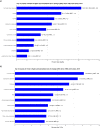A GBD 2019 study of health and Sustainable Development Goal gains and forecasts to 2030 in Spain
- PMID: 36477107
- PMCID: PMC9729199
- DOI: 10.1038/s41598-022-24719-z
A GBD 2019 study of health and Sustainable Development Goal gains and forecasts to 2030 in Spain
Abstract
This study aimed to report mortality, risk factors, and burden of diseases in Spain. The Global Burden of Disease, Injuries, and Risk Factors 2019 estimates the burden due to 369 diseases, injuries, and impairments and 87 risk factors and risk factor combinations. Here, we detail the updated Spain 1990-2019 burden of disease estimates and project certain metrics up to 2030. In 2019, leading causes of death were ischaemic heart disease, stroke, chronic obstructive pulmonary disease, Alzheimer's disease, and lung cancer. Main causes of disability adjusted life years (DALYs) were ischaemic heart disease, diabetes, lung cancer, low back pain, and stroke. Leading DALYs risk factors included smoking, high body mass index, and high fasting plasma glucose. Spain scored 74/100 among all health-related Sustainable Development Goals (SDGs) indicators, ranking 20 of 195 countries and territories. We forecasted that by 2030, Spain would outpace Japan, the United States, and the European Union. Behavioural risk factors, such as smoking and poor diet, and environmental factors added a significant burden to the Spanish population's health in 2019. Monitoring these trends, particularly in light of COVID-19, is essential to prioritise interventions that will reduce the future burden of disease to meet population health and SDG commitments.
© 2022. The Author(s).
Conflict of interest statement
J.V.L. reports grants from AbbVie, Gilead Sciences, MSD, and Roche Diagnostics; consulting fees from NovoVax; payment or honoraria for lectures, presentations, speakers’ bureaus, and educational events from AbbVie, Gilead, Sciences, Intercept, and Janssen; participation on a Data Safety Monitoring Board with the QuickStart Study; and leadership, unpaid, with the EASL international Liver Foundation and HIV Outcomes; all outside the submitted work. A.O. reports (all outside the submitted work) grants from Sanofi and consultancy or speaker fees or travel support from Advicciene, Astellas, Astrazeneca, Amicus, Amgen, Fresenius Medical Care, GSK, Bayer, Sanofi-Genzyme, Menarini, Kyowa Kirin, Alexion, Idorsia, Chiesi, Otsuka, Novo-Nordisk, and Vifor Fresenius Medical Care Renal Pharma and is Director of the Catedra Mundipharma-UAM of diabetic kidney disease and the Catedra Astrazeneca-UAM of chronic kidney disease and electrolytes. All other authors declare no competing interests.
Figures






References
-
- Bernal, E. et al. Spain: Health system review. In Health Systems in Transition, Vol. 20 (2018). - PubMed
-
- Benach J, Friel S, Houweling T, et al. A Conceptual Framework for Action on the Social Determinants of Health. World Health Organization; 2010.

